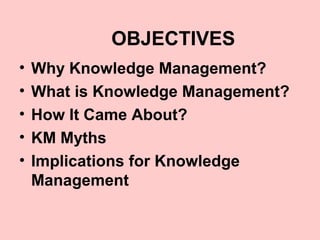
Chapter 1a
- 1. OBJECTIVES • Why Knowledge Management? • What is Knowledge Management? • How It Came About? • KM Myths • Implications for Knowledge Management
- 2. Economic reliance on knowledge workers is increasing • Knowledge gap • Customers and businesses want a more integrated approach • Best to say you are in the knowledge business
- 3. WHY KM? • Consumer to Prosumer: more educated customers, they demand more. • Exponential benefits: as people learn from it. • Makes business processes faster and more effective. positive impact. • Enables the organization to position itself for responding quickly to customers, creating new markets, developing new products and dominating emergent technologies. • Builds mutual trust between knowledge workers and the management. • Facilitates cooperation in handling Time-Sensitive tasks. • Empowers employees in a unique way. • Helps capture tacit knowledge. • Intangible return on knowledge sharing than on knowledge hoarding. • Building better sensitivity to Brain Drain:” expertise gravitates towards the highest bidder”. • Ensuring successful partnering and core competencies. • Shortens the learning curve, facilitates sharing of knowledge.
- 4. DEFINITIONS • KM is a newly emerging interdisciplinary business model dealing with all aspects of knowledge with in the context of the firm, including knowledge creation, codification, sharing, and how these activities promote learning and innovation (encompassing technology tools and organizational routines in overlapping parts). • KM is the process of gathering a firm’s collective expertise wherever it resides-in databases, on paper, or in people’s heads-and distributing it to where it can help produce the biggest payoff. • KM is not about technology; it is about mapping processes and exploiting the knowledge database. It is applying technology to people’s mind. • KM is a discipline of identifying, capturing, retrieving, sharing, and evaluating an enterprise’s information assets.
- 5. HOW IT CAME ABOUT • The pace of change has accelerated dramatically during the past decade. • Globalization and geographic dispersion changed the organisation’s scope. • Downsizing and reengineering resulted in staff attrition and knowledge drain. • Networking and data communication made it easier and faster to share knowledge. • The increasing dominance of knowledge as a basis for improving efficiency and effectiveness.
- 6. FACTORS OF KM PEOPLE (Work Force) ORGANISATIONAL KNOWLEDGE PROCESSES TECHNOLOGY (IT Infrastructure)
- 7. UNCAPTURED TACIT KNOWLEDGE Oral Communication “Tacit” Knowledge 50%-95% Information Request Explicit “ Explicit” Knowledge Knowledge Base 5% Information Feedback
- 8. THE KNOWLEDGE ORGANISATION CULTURE TECHNOLOGY COMPETITION COLLECT CREATE ORGANISE KNOWLEDGE INTELLIGENCE MAINTAIN ORGANISATION REFINE DISSEMINATE LEADERSHIP KM KM DRIVERS PROCESS
- 9. IDEAL KM Strategy Measurement Policy Content Process Technology Culture Knowledge Internalization Knowledge Knowledge People Assets Reuse Knowledge Knowledge Exchange Capture Knowledge People Exchange Knowledge People
- 10. WHAT KM IS NOT ABOUT • KM is not reengineering. • KM is not a discipline. • KM is not a philosophic calling. • KM is not intellectual capital. • KM is not based on information. (K has been viewed as info. in action) • KM is not about data. • Knowledge value chain is not information value chain. • KM is not digital network. • KM is not limited to gathering information from company’s domain.
- 11. KM AND INNOVATION Existing •New Products Outside Methods/ Environment •New Markets Processes Learning •Smarter problem- solving Conversion •Value-added People New Insights innovation Ideas •Better customer Knowledge service Creation •More efficient processes •More Experienced staff Knowledge Base Organizational Benefits
- 12. THE KM CYCLE AND THE ORGANISATION Organizational Management Personnel Decision Making KM Life Cycle •Capture •Gather •Organize •Refine Culture Information Technology
- 13. FOUR PROCESS VIEW OF KM CAPTURING ORGANIZING •Data Entry •Cataloging •Scanning •Indexing •Voice Input •Filtering •Interviewing •Linking •Brain Storming •Codifying TRANSFER REFINING •Flow •Contextualizing •Sharing •Collaborating •Alert •Compacting •Push •Projecting •Mining
- 14. KEY CHALLENGES • What Km is and it can benefit a corporate environment? • How to evaluate the firm’s core knowledge? • How knowledge can be captured, processed, and acted on? • How to address the still neglected areas of collaboration? • Continue researching KM to improve and expand its current capabilities?
